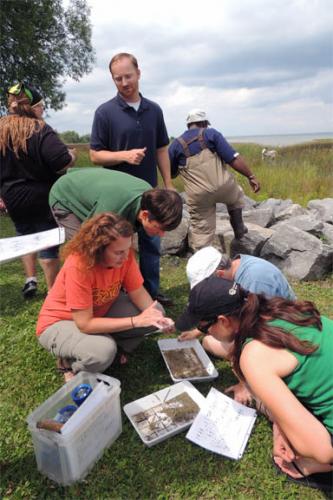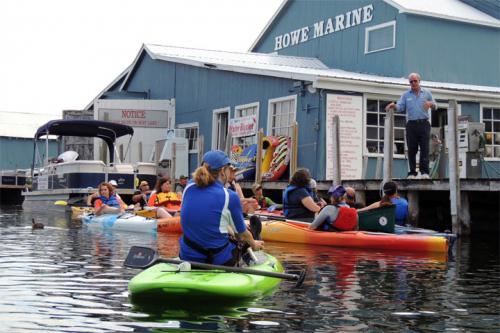Educators explore Great Lakes watershed science during Lake Huron adventure (Part 2 of 3)
Lake Huron educators take a watershed approach in exploring student learning opportunities through educational Great Lakes science and stewardship opportunities.
While kayaking the river and wading coastal wetlands in waders, twenty enthusiastic educators took to the waters of Lake Huron with Great Lakes scientists to explore how water scie nce and studies can benefit student learning. These Great Lakes water science experiences were part of the 2013 Lake Huron Place-Based Education Summer Teacher Institute (see part 1 of story), hosted August 5 - 8 in northern Michigan at the University of Michigan Biological Station.
nce and studies can benefit student learning. These Great Lakes water science experiences were part of the 2013 Lake Huron Place-Based Education Summer Teacher Institute (see part 1 of story), hosted August 5 - 8 in northern Michigan at the University of Michigan Biological Station.
Exploring Great Lakes watersheds, from top to bottom, was the focus of one water-based day for these teachers. Starting in Burt Lake, they kayaked downriver and through the town of Indian River. Before the day was up, they found themselves exploring a coastal Great Lakes wetland in Cheboygan, where this watershed feeds into Lake Huron. Along the way, teachers compared and contrasted a diversity of water habitats g from inland lakes, rivers, to coastal wetland habits – such as differing aquatic life.
Teachers explored multiple water stewardship-focused student projects in action, and considered many prospective place-based learning project possibilities throughout the watershed as they spoke with research scientists, community partners, and fellow educators. Their watershed day included:
- A kayak tour of upper stretches of the river learning about Inland Lakes NE MI GLSI student projects—from water monitoring by a science class to riverfront boardwalks and township riverfront park beautification built and developed by students Inland Lakes industrial arts program. They also visited a Michigan Clean Marina – Howe Marine (Indian River)— where owner John Hatfield discussed stewardship opportunities for students working with Clean Marinas.
- Exploration of Lake Huron coastal wetlands with Neil Schock, wetlands researcher from Central Michigan University’s Institute for Great Lakes Research. Teachers learned about ecological values of Great Lakes coastal wetlands and explored chemical, physical, and biological monitoring techniques, including opportunities to sample macroinvertebrates as a way to determine ecosystem health. On the shores of Lake Huron, Thunder Bay Jr. High teachers from Alpena shared their students’ involvement with Alliance for the Great Lakes and the Adopt-a-Beach program.
- Gaining an underwater perspective on Douglas Lake, the lake on which the Biological Station resides. Learning about technology of underwater robotics with NOAA Thunder Bay National Marine Sanctuary, teachers deployed an underwater remote operated vehicle (ROV) to gain an underwater view of Douglas Lake habitats. Applying science and math, they also took to the water with Michigan Sea Grant and Michigan State University Extension educators to explore fisheries and aquatic invasive species found within the Lake.
 Sponsored by the Great Lakes Sea Grant Network and Michigan Sea Grant Extension , the Center for Great Lakes Literacy and Great Lakes Stewardship Initiative, this workshop offered educators opportunities to enhance Great Lakes literacy through place-based education strategies – a better understanding of the Great Lakes and our interconnections with these water resources. As another school year gets underway, these teachers are already sharing their Great Lakes experiences and learning opportunities with their students.
Sponsored by the Great Lakes Sea Grant Network and Michigan Sea Grant Extension , the Center for Great Lakes Literacy and Great Lakes Stewardship Initiative, this workshop offered educators opportunities to enhance Great Lakes literacy through place-based education strategies – a better understanding of the Great Lakes and our interconnections with these water resources. As another school year gets underway, these teachers are already sharing their Great Lakes experiences and learning opportunities with their students.
One teacher from Southeast Michigan is now collaborating with the Clinton River Watershed Council, where her students are supporting water-monitoring efforts. From the Northeast Michigan Great Lakes Stewardship Initiative, two different teams of middle school teachers are preparing their students for adopt-a-beach monitoring and clean-up projects in their communities this fall, one in Alpena and another in Oscoda. A third Northeast teacher will be taking her high school chemistry students out onto Thunder Bay Lake Huron, embarking on a research trip to study microplastics (plastic pollution) in the Great Lakes.
In reflection, a teacher noted that the on-the-water experiences were the most valuable part of her workshop experience, sharing that these types of experiences can help make learning real and concrete for students. Incorporating these experiences back at her school, she aims to make science-learning come alive to engage and inspire the next generation of Great Lakes stewards.
Stay tuned for Part 3 of this series, where teachers explore Great Lakes fisheries learning opportunities connected with the ancient and threatened Lake Sturgeon!



 Print
Print Email
Email




